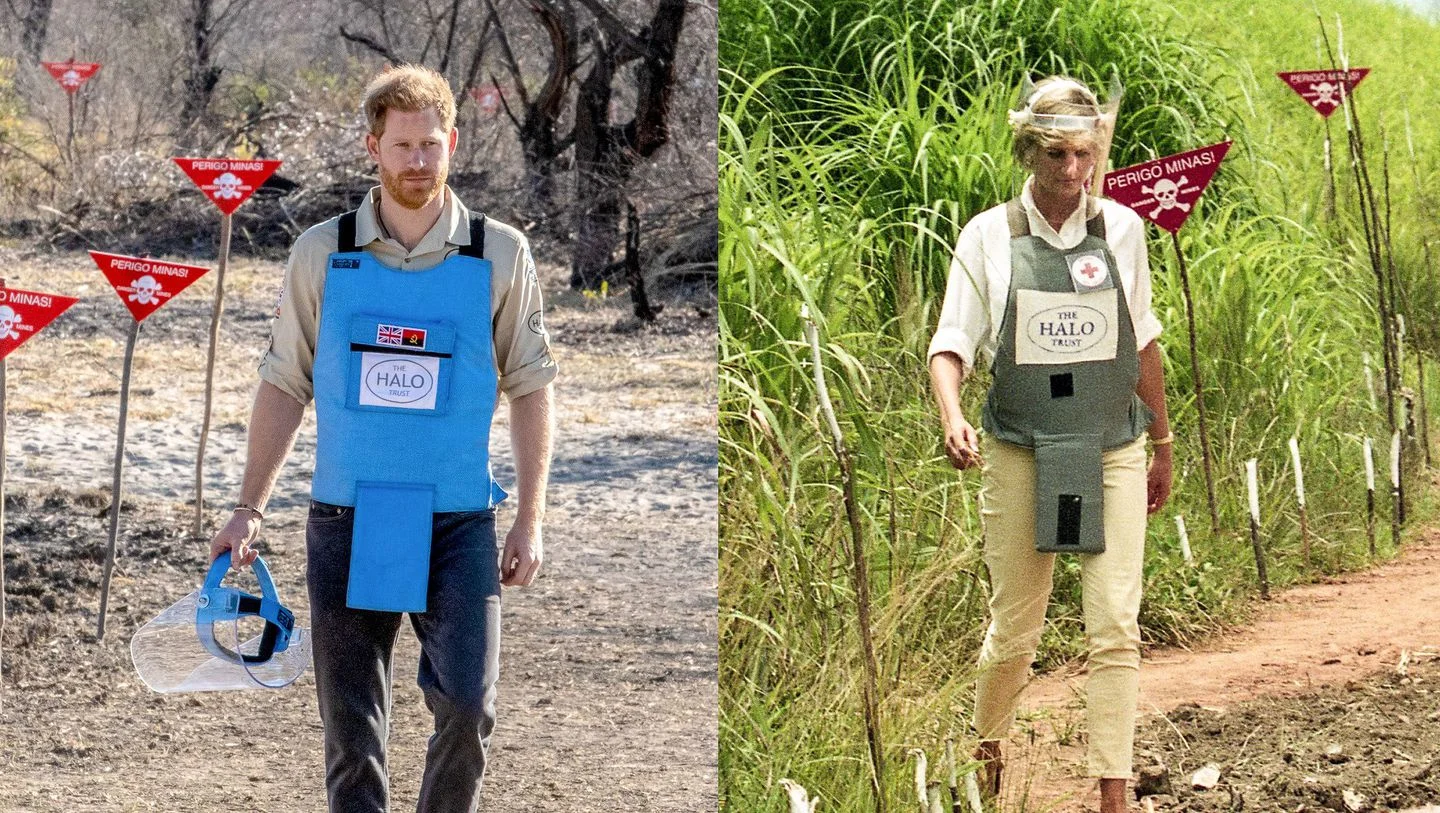Prince Harry Retraces Diana's Steps in Angola's Minefields, Hoping to Bring Elephants Home
/Prince Harry visits a minefield in Dirico, Angola, on Sept. 27. On the right, his late mother Diana, Princess of Wales, during her visit to a minefield in Angola on Jan. 15, 1997. (Halo Trust/AFP/ image via Washington Post.
Prince Harry surely reflected on his mother Princess Diana, as he retraced her footsteps Friday in the Angolan city of Huambo. Homes and shops now line the path, and 22 years later, 133 countries have signed an international treaty banning land mines.
Angola continues to suffer from the ravages of a bloody civil war that ended in 2002.
“Land mines are an unhealed scar of war,” said Prince Harry, whose quick trip trip to Angola this week highlighted two sides of nation: urban centers that are largely mine-free, and a countryside where danger persists, people continue to suffer when a landmine explodes, and the economic development — particularly in the luxury tourism industry — is thwarted because of the mines.
The Washington Post writes that the US was once Angola’s primary benefactor in the landmine cleanup, funneling $129 million to the effort since 1993. America’s own ongoing wars in Iraq and Afghanistan have dried up the funding, virtually guaranteeing that Angola will not be mine-free by 2025.
“At the current rate of funding, Angola won’t be land-mine-free until 2046,” said Alex Vines, head of the Africa Program at Chatham House, a global think tank.
“There is still a huge amount to do,” Prince Harry told a London audience in June. “The fact that funding has been reduced by 90 percent over the last decade is pretty shocking.”
The Halo Trust, the British mine-clearance nonprofit organization that hosted Prince Harry, estimates that about 1,200 minefields remain in Angola. They cover 26,000 acres of some of the most precious nature preserve land in the world.
Prince Harry walks down Princess Diana Street in Huambo, Angola, during the royal tour of Africa on Sept. 27. (Dominic Lipinski/Pool/AP) via Washington Post
Bringing Back Angola’s Refugee Elephants
Thirty years after the battle of Cuito Cuanavale, the largest battle fought on African soil since the Second World War, Angola has a plan to bring home thousands of “refugee” elephants who fled the catastrophic fighting and landmines.
Paula Coelho, Angola's environment minister, has the support of the Duke of Sussex and The Halo Trust, with her plan to clear 153 mine fields around the headwaters of the Okavango River.
It’s estimated that there are only about 3,300 elephants in Angola today, based on a 2016 study. The Telegraph UK interviewed Coelho in late June, writing:
That is a fraction of the 250,000 elephants, or roughly half Africa’s surviving population, estimated to live in the Kavango and Zambezi (KOZA) river ecosystem, a sprawling landscape of river, swamp and savanna that includes Botswana, Namibia, Zambia, and Zimbabwe, as well as a large chunk of southeastern Angola.
The minister believes that bringing elephants back to a safe Angola will boot tourism with positive impacts also on agriculture and Angolan citizens health, safety and economic wellbeing.
It is also a PR exercise, designed to prove to foreign governments and investors that Angola has moved on from what she calls an era of “kleptocracy”, writes The Telegraph.
Paula Coelho, Angola's environment minister speaking in London, June 2019
"Angola has for a long time been seen as a closed paranoid authoritarian country. Now this is all out," she told a gathering that included Rory Stewart, the international development secretary, at Chatham House last week. "Angola knows its needs to develop and preserve its environment. We are looking for assistance."
Angola is one of the most active members of the Elephant Protection Initiative, a British-backed alliance of African governments committed to ending the ivory trade. Coelho also argues that the more precarious situation of elephants in Botswana, given the recent lifting of the country’s ban on trophy hunting, makes Angola’s efforts to clear the minefields imperative for elephants’ futures.
Botswana, home to almost one-third of Africa's 450,000 elephants, has seen its number of elephants triple to an estimated 160,000 since 1991, according to statistics provided by the government.
Related



![Into-the-Okavango_[Neil-Gelinas]_3-dbl.jpg](https://images.squarespace-cdn.com/content/v1/55f45174e4b0fb5d95b07f39/1561937163642-AJXZW3I471QGTYL0AE03/Into-the-Okavango_%5BNeil-Gelinas%5D_3-dbl.jpg)
































